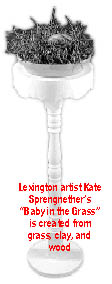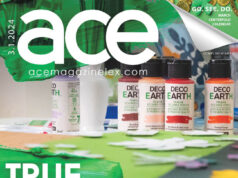Not Just Vagina Art
Kentucky women artists create for the new millennium
By Kara Fitzgerald
….the Goddess has never died, and one of the major spiritual and psychological phenomena of our time has been her reemergence as a significant presence in our lives….Goddess is returning because she is needed.”
-David Leeming & Jake Page,
Goddess Myths of the Female Divine.
When the Living Arts and Science Center announced their call for entries for Woman: Force of the New Millennium, a juried exhibit open to all women artists of Kentucky, over 60 women responded. Works from various media poured in, from ceramics to painting to photography to sculpture and fiber, but not all of them celebrated the importance and force of women in the new millennium and the reemergence of female strength-the theme for the show. Only 29 pieces were selected as reflecting the theme and of encouraging women to examine the mythology, theology, culture, and politics (past, present, and future) of the “divine female” in themselves or in other women as they enter the third millennium.
Woman: For

“Even though we exhibit a lot of single women artists at The Living Arts and Science Center, we haven’t had an actual woman’s theme show in quite awhile, and ArtsPlace started this MillenniaSpan where 

Along with their slides, the artists/goddesses had to submit a statement about how their piece worked in with the theme, which the jurors weighted heavily. The jurors for the exhibit were: Lisa Blackadar, curator of Headley-Whitney Museum; Marsha Heidbrink, an artist from Alvaton; and Barbara Houghton, a professor of art at Northern Kentucky University.
The majority of the women who were selected are from Lexington or Louisville, but there are artists from Whitesville, Fort Thomas, Somerset, Olive Hill, and Berea as well.
A Photograph is a secret about a secret. The more it tells you the less you know. I really believe there are things nobody would see if I didn’t photograph them.
-photographer Diane Arbus
“When they sent out the requests for submissions I had been working for the last year on a project, The Face of AIDS in Kentucky, and Penny was one of the people involved with that project. I had already had contact with her, but as result of thinking about the millennium request and this show I decided to incorporate her in that, so it came out of my work with people with AIDS. When I thought about women in the millennium, I decided to look at that as something I would want to present and talk about,” says Peggy Blythe explaining her photograph, which won first place in the exhibit.

Blythe is a photographer who has focused her work on environmental portraiture and social documentaries. She is also a longtime photographer for Ace Magazine and has received grants to teach photography to children and adults, as well as document the lives of teen parents.
“I was very excited when I won. One of the things I was concerned about was I thought they’d want it to be real upbeat, happy, or positive, and this picture to me is an intense picture and not something that you would look at and feel positive immediately, but I think the meaning behind it and what is going on by her reaching out to other people hopefully will have a positive effect on others,” says Blythe.
Blythe’s work as a counselor often inspires her to pick up her camera. She says she enjoys getting to know people and being in their environment.
“I think it’s because people fascinate me….how they live their lives, what their experiences are. I do look intensely at them and I think it shows visually. Often people kid me that I ask too many questions. I do it verbally and visually. I’m just very interested in people and in finding out about their lives and how they work. I think it’s reflected both ways, but that’s definitely what I’m interested in… relationships, connectedness, those are things I’m always looking at when I talk to people,” says Blythe.
Getting back to Penny, Blythe says, “I think I would like people to think of her as a person. In my statement, I mentioned where I think in the course of this millennium women have gotten a lot of sexual freedom which I think has been very important for women-and at the same time we’ve had to bear the responsibilities and consequences moreso of sex and the choices we make. So it’s a two-sided thing. Penny had the conviction that she wanted to help other women and that’s why she’s willing to put her face out there. A lot of people who have AIDS don’t want other people to know that. She is a woman trying to help other women through her own experience, so I hope they’d think twice about their own choices and appreciate Penny’s effort to reach out to them That’s what I would hope to happen as a result of this…of looking in her face.”
Penny plans on attending

Something completely different is Glynis Mary McManamon’s Eve Y2K. It’s a mixed media piece that includes a barbie doll head in a jar, sequins, antennae…well, just keep reading.
“On the top of this long box is a head of a woman. It’s a wig stand that has been collaged with a lot of different messages that women take in. It has antennae and on the left brain it’s all gray and the messages on the right side are the messages of who we should be and the roles we should take on. On the right side, the antennae are very colorful and it’s got a lot of sequins and the left side of the women’s head is the creative thinking…the possibilities, the independent thinking. The outside is painted like night and there are three constellations. On the inside of the box there’s a branch of a tree and the tree rises up and there’s women’s names of history carved from the bottom to the top, first name being Eve. There’s a barbie doll in a jar dressed in fig leaves and she has an apple core and it says Eve on it, like it would be a labeled biology specimen. There’s a little note tacked to it that says ‘no regrets,'” says McManamon taking a long breath.
In the background there is a daytime sky. There are golden leaves that have fallen, but green leaves still on the branches. There are different faces of women, some famous and some unknown, coming through all over the place. At first you don’t notice it, but there’s an apple hanging from the top of the box painted in colorful stripes, much like a well-known logo.
“One of the things that struck me in researching about Eve was that the Mormon Church has a whole different take on Eve. They think she was very courageous and she was given a choice and she made a choice. If she hadn’t made a choice, from the mythical perspective, none of us would be here. So, a lot of times as women have made choices over history they’ve taken a lot of flack for it. In the church in particular, for a long time the tradition was to blame everything on Eve. ‘Well if she hadn’t done it there wouldn’t be sin….’ so I would hope it is an affirming piece for women who’ve maybe made difficult choices. And because there’s anonymous women in with famous women, there’s a sense that everyone of us has made a contribution,” says McManamon.
There’s been such a powerful movement of women this second half of the century, according to McManamon, who describes it as a “critical mass”-a bursting force of energy.
“Maybe things will come back to an equilibrium that’s been lost. It’s also a message of hope for women….with every new year you get a fresh start,” McManamon concludes.
McManamon is a Sister of Good Shepherd, a Catholic sisterhood dedicated to empowering women and girls in social, emotional and spiritual distress.
“I do think women have come farfrom 1900-2000. It’s important to mark that and I’m glad The Living Arts and Science Center is doing this,” says Michelle Kellond Amos, who won an Honorable Mention.
Amos’ piece is 36″ tall and it’s created out of raffia and reed and sound sticks.
“It was my experiences growing up in government funding housing in Louisville contrasted with my college summers fishing in Alaska that led me to question environment and equality. My designs reflect my desire to see female imagery as sacred space and nature as relevant question. My images are feminine and cocoon-like in nature to suggest female leadership birthing our transition into a more balanced society,” says Amos.
Amos wanted to study women in college and felt it was important to know more about women’s history which she says is often written out, especially in the arts. “That’s why you have groups like the Guerrilla Girls out there now trying to push that women be represented and I feel really strongly about that and that’s why I was really interested in this show.
“A lot of times, I guess this is my interconflict, I worry that my art is too abstract…not for an art crowd, but sometimes I think it’s too abstract for everyday people, people who aren’t in the arts. I try to put subtle messages in my work. This piece wasn’t a message about women, it’s more a celebration of women and I do feel women leadership in the next millennium will be real important. I see women gaining more strength and leadership. I think the more you see women represented in powerful places in society there’s going to be some major shift…I hope so. With that piece I did and with a lot of my pieces I really just want to open dialogue up about women’s history and about celebrating women. The front of it, the opening, is referencing the vulva because you see so many phallic symbols. I actually did a seminar with Judy Chicago and the one thing I remember was her telling us to close our eyes and think of the womb and this really warm place and what our cities would be like if they had been constructed by women and she said then open your eyes and imagine you’re in New York city. You’d scream ‘look at all these phallic symbols!'”
Amos has been working on a variety of large scale pieces that you can actually crawl into-they are womb like, woven pieces.
Kate Sprengnether, who also received an Honorable Mention, has a mixed media construction of grass, clay, and wood entitled Baby in the Grass.
“It’s a baby shape/fetus shape that looks like a bean. It’s nestled in grass and it means something about this little bean that’s protected by the earth and that’s nurtured by the earth. This little baby, and I don’t know who that is, is something that has appeared in my work the last several years,” says Sprengnether.
Sprengnether says the exhibit will start off the millennium on a good foot.
“I know there are a lot of people, and I’ve done some reading, who think this next millennium and the years to come, we’ll be turning back to a more matriarchal society and I think that may be happening and we may be seeing the beginnings of that. It’s not about women excluding men. I think it’s more about the female aspect in all of us.”
Sprengnether says she wants people to walk away from her work with a sense of nurturing and spirituality.
Second place winner Jamison Brumm’s Spirit I looks like a shooting flame, complete with radiant colors and irregular edges. It’s made from anodized aluminum with glass and crystal beads and stands 6″ tall.
“My jewelry lines are mainly inspired by partnerships in which men and women are equal. All of my work is oriented toward this goal to promote equality between the sexes. I feel that one of our problems in today’s society, for whatever reason, is that men have been in control of many different things and our world’s a little imbalanced and so the piece that I did for this exhibit is called Spirit and it’s a feminine presence descending to the earth, and to me it symbolizes the need for women to respond to the call to leadership so that men and women can co-lead,” Brumm says.
Brumm dyes, engraves, cuts, hammers, and assembles her pieces using the anodized aluminum. Her two lines of jewelry, Age Glyphs and Earth Glyphs, are quite popular. The Age Glyph incorporates ancient carvings and hieroglphs which have special meaning to women, and the Earth Glyphs are inspired by a love of nature.
“The meaning of a word -to me-is not as exact as the meaning of color. Colors and shapes make a more definite statement than words.”
-Georgia O’Keeffe
Linda Horvay Barnes’ quilt is made of various pieces of mostly florals that are pieced together in squares to look like a gradation, like a watercolor quilt. The central image is of a woman in various shades of sky blue bending over backwards.
“It’s actually the Egyptian goddess, her name is Nut. Normally this Egyptian goddess would be bending forwards. She represents the heavens, the goddess of the heavens in mythology, and she would be looking over her children which is the earth and protecting it. But, in this case I have her doing a yoga pose bending over backwards because I see her as kind of vulnerable, she’s straining at the same time she’s trying to keep her spine supple so she can do everything that she has to do,” says Barnes.
This piece is one Barnes created especially for the exhibit. She has been painting and quilting for 20 years.
“I think women are under stress and I think they’re still trying to keep in shape and keep up and that’s how my woman is. She’s trying to center herself, trying to keep things going and it’s difficult. Using mythology is a neat way to present an idea, especially with art because it’s not a linear way of thinking which often leads to false conclusions. So you’re not rationalizing or leading to any conclusions, you’re presenting an image you can see on several different levels at the same time and I think that’s what we have to do to survive…keep the big picture in mind and tend to the shirt button holes and the fabric, keep it together and keep ourselves together.”
Woman: Force of the New Millennium opens on January 16 at 2pm and runs through March 25. Call 255-2284 or 252-5222 for more information.








